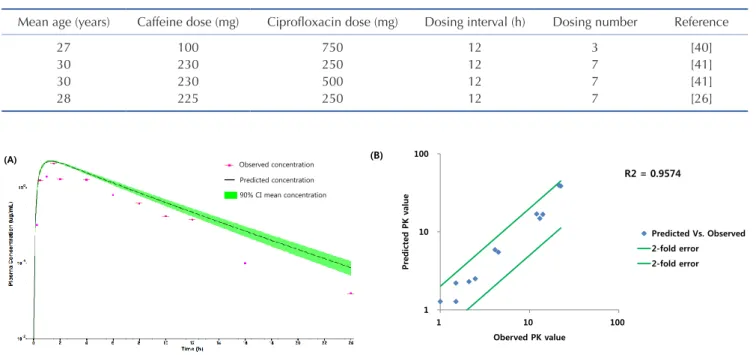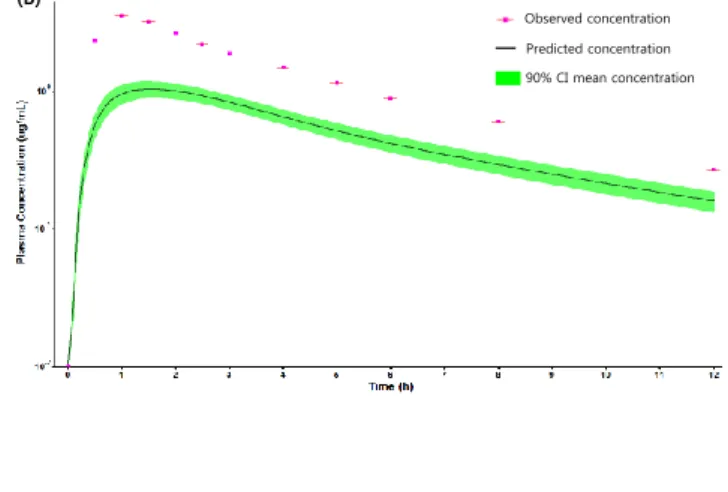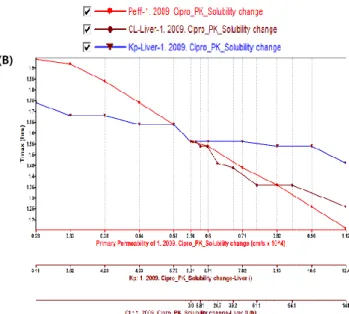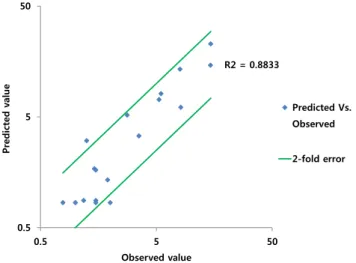www.kjpp.net 107 Korean J Physiol Pharmacol 2017;21(1):107-115 Author contributions: M.H.P., S.H.S. and J.J.B. performed the modeling and simulation. G.H.L., B.Y.Y. and Y.G.S. supervised and coordinated the study. M.H.P. wrote the manuscript.
This is an Open Access article distributed under the terms of the Creative Commons Attribution Non-Commercial License, which permits unrestricted non-commercial use, distribution, and reproduction in any medium, provided the original work is properly cited.
Copyright © Korean J Physiol Pharmacol, pISSN 1226-4512, eISSN 2093-3827
INTRODUCTION
Understanding absorption, distribution, metabolism, excretion (ADME) as well as pharmacokinetics (PK) is critical in drug discovery and development. This approach typically begins early in the drug discovery phase, when hit compounds are available.
As the project moves forward to the lead optimization phase, ADME/PK contributes significantly in rank-ordering compounds for further testing, aids in the dose selection in nonclinical in vivo pharmacology studies, establishes structure-activity relationships (SAR) for structural modifications to improve the
physicochemical and ADME properties and eventually supports candidate selection [1]. Once a candidate is selected, human PK prediction can also be conducted to estimate the dose-dependent drug exposure and its anticipated pharmacological response as well as the potential toxicological effects or even the potential drug-drug interactions.
Drug-drug interactions (DDIs) have led to contraindications, withdrawal from the market and non-approval of drugs by regulatory agencies [2]. Therefore, prediction for a potential risk of DDIs between the candidate drug and the co-administered drugs would be very important within the pharmaceutical
Original Article
Prediction of pharmacokinetics and drug-drug interaction potential using physiologically based pharmacokinetic (PBPK) modeling approach: A case study of caffeine and ciprofloxacin
Min-Ho Park 1 , Seok-Ho Shin 1 , Jin-Ju Byeon 1 , Gwan-Ho Lee 2 , Byung-Yong Yu 3 , and Young G. Shin 1, *
1
College of Pharmacy, Chungnam National University, Daejeon 34134,
2Department of Chemistry and Research Institute for Basic Sciences, Kyung Hee University, Seoul 02453,
3Advanced Analysis Center, Korea Institute of Science and Technology, Seoul 02792, Korea
ARTICLE INFO Received October 5, 2016 Revised November 7, 2016 Accepted November 14, 2016
*Correspondence Young G. Shin E-mail: yshin@cnu.ac.kr Key Words
Caffeine Ciprofloxacin Drug-drug interaction
Physiologically based pharmacokinetics
ABSTRACT Over the last decade, physiologically based pharmacokinetics (PBPK) application has been extended significantly not only to predicting preclinical/
human PK but also to evaluating the drug-drug interaction (DDI) liability at the
drug discovery or development stage. Herein, we describe a case study to illustrate
the use of PBPK approach in predicting human PK as well as DDI using in silico, in
vivo and in vitro derived parameters. This case was composed of five steps such
as: simulation, verification, understanding of parameter sensitivity, optimization
of the parameter and final evaluation. Caffeine and ciprofloxacin were used as tool
compounds to demonstrate the “fit for purpose” application of PBPK modeling and
simulation for this study. Compared to caffeine, the PBPK modeling for ciprofloxacin
was challenging due to several factors including solubility, permeability, clearance
and tissue distribution etc. Therefore, intensive parameter sensitivity analysis (PSA)
was conducted to optimize the PBPK model for ciprofloxacin. Overall, the increase
in C
maxof caffeine by ciprofloxacin was not significant. However, the increase in AUC
was observed and was proportional to the administered dose of ciprofloxacin. The
predicted DDI and PK results were comparable to observed clinical data published
in the literatures. This approach would be helpful in identifying potential key
factors that could lead to significant impact on PBPK modeling and simulation for
challenging compounds.
industry in order to improve the safety and success rate of new drugs. Early prediction of DDIs has also become useful to support clinical candidate selection. DDI studies and their interpretation have been described in a white paper from the Pharmaceutical Research and Manufacturers of America (PhRMA) [3] and in a guidance document from the US FDA.
Over the last decade, model-based PK/DDI prediction using in- vitro data has been increased significantly [4,5]. Initially, simple empirical static models were applied to evaluate the DDI risk to predict steady state DDI [6-9]. However, these static models are often restricted when predicting the ratio of substrate exposures before and after perpetrator treatment and are unable to simulate dynamic state DDI. Therefore, a dynamic DDI modeling and simulation has been proposed to predict DDI which can represent in vivo DDI more realistically [10]. Recently, the development of physiologically-based pharmacokinetic (PBPK) models has extended to the DDI evaluation of dynamic approaches with the ability to simulate time-varying substrate and perpetrator kinetics at interaction sites [11-13]. In addition, commercial programs (e.g. GastroPlus
Ⓡ, Simcyp
Ⓡ) dedicated to DDI predictions are also introduced which could combine both in vitro/in vivo data and clinical study results to help the evaluation of dynamic DDIs more efficiently. The PBPK model is typically composed of specific compartments corresponding to different body tissues and these tissues were also connected by the circulating blood system. Each compartment is defined by a tissue-specific volume, blood perfusion rate, enzyme/transporter expression levels and tissue-plasma partition coefficient (Kp) etc [13].
Herein, we describe a case study using caffeine and cipro- floxacin to illustrate the use of GastroPlus in predicting PK and DDI liability using in silico, in vivo and in vitro derived parameters. This case is composed of five processes such as (1) simulation, (2) verification, (3) understanding of parameter sen- sitivity, (4) optimization of the parameter and (5) final evaluation.
The objective of this study is to demonstrate the application of in silico tools for simulation, process for understanding of drug parameter sensitivity, optimization of drug parameter, evaluation of PBPK model to provide a satisfactory prediction of PK profile and DDI result. However, it should be emphasized that these simulations are quite dependent on the quality of the input parameters and mechanistic understanding of the processes driving PK. A number of more detailed case studies using in silico program are also available in the literature illustrating the value of such modeling and simulation techniques [14-18].
mEThODS
PBPK modeling program
All modelings were performed using GastroPlus (Version 9.0).
The physicochemical and ADME properties of compounds were
estimated and optimized by the ADMET predictor module in GastroPlus.
The Advanced Compartmental Absorption Transit (ACAT) model was used to predict the rate and extent of oral absorption in human. The ACAT model is based on the Compartmental Absorption Transit (CAT) model described by Yu and Amidon [19]. In short, this model is a physiologically based transit model which describes the dissolution, uptake and absorption of a compound as it transits through the different segments of the digestive tract. Several in vitro and in silico input data, e.g.
solubility, permeability, logP, particle size, acid dissociation constant (pKa) etc with a series of differential equations were also used to model the kinetics associated with each of these processes.
Each organ was also assumed to be perfusion rate limited, and the liver and kidney were considered to be the only organs to eliminate the compounds in this study.
Volume of distribution at steady-state (Vss) was estimated using the predicted tissue-to-plasma partition coefficient (Ptp) [20]. The predicted Ptp values for each tissue were obtained from drug-specific physicochemical parameters using the tissue composition-based equation derived from Poulin and Theil [21]. These equations assume that the compound distributes homogenously into the tissue and plasma by passive diffusion and accounts for both nonspecific binding to lipids and plasma proteins estimated by lipophilicity and plasma protein binding (PPB), respectively.
Compounds and PBPK modeling
The physicochemical properties of caffeine and ciprofloxacin are summarized in Table 1. The workflow for PBPK modeling is also presented in Fig. 1. Firstly, a PBPK model for each compound was built in human. And then, the model was compared with the observed PK data published in the literature. If the PBPK model data were not close enough to the observed data, the parameter sensitivity analysis (PSA) was performed to understand the root cause of discrepancy between the observed PK data and the simulated PBPK data until the root cause of discrepancy is discovered. Once the simulated PBPK model was verified, it was re-evaluated by other new PK data to confirm its predictability.
Finally the DDI prediction was performed and evaluated using the confirmed PBPK models. References for verification and evaluation of PBPK model were summarized in Table 2.
The physicochemical and ADME properties of caffeine such as pKa, logP, unbound fraction, permeability, solubility, clearance (CL) by liver (or kidney), and blood/plasma ratio etc were estimated by the ADMET predictor module in GastroPlus. The PBPK modeling of caffeine was performed as mentioned above.
The physicochemical and ADME properties of ciprofloxacin were also estimated by ADMET predictor module in GastroPlus and PBPK modeling was conducted as mentioned above.
The PBPK model was assessed in terms of the fold error
between the observed values and the predicted values. The following statistics were used to assess the prediction accuracy.
The fold-error= Predicted value Observed value
The R
2statistic (square of the Pearson product moment correlation coefficient) was used to quantify the extent of linear relationship between predicted and observed parameters. In this study, two-fold error would be an acceptable prediction which is also widely applied within pharmaceutical industries [15,22-24].
DDI modeling and simulation
DDI modeling for caffeine and ciprofloxacin was conducted using the dynamic simulation in DDI module of GastroPlus.
The verified PBPK models were used for DDI prediction by considering the inhibitory effect of ciprofloxacin as a perpetrator on caffeine. Caffeine was assumed to be exclusively metabolized by the metabolic enzyme CYP1A2 without significant invol- vement of any other drug transporters or metabolic enzymes in this DDI simulation. Although several clinical PK studies for caffeine or ciprofloxacin had been previously reported, the full concentration-time profile data by DDI between caffeine and ciprofloxacin were quite limited. In this study, PK results from
Table 1. Summary of caffeine and ciprofloxacin input parameters in gastroPlus
Parameter Caffeine Ciprofloxacin
Predicted value* Predicted value Optimized value
Molecular weight (g/mol) 194.19 331.35 331.35
LogP(
neutral) –0.15 –0.81 –0.81
Ionization constant (pKa) 2.24 (base) 8.9 (Base)
5.78 (Acid) 0.98 (Base)
8.9 (Base) 5.78 (Acid) 0.98 (Base)
Unbound fraction (fu) (%) 71.54 67.05 67.05
Blood/plasma ratio 1.03 0.96 0.96
Clearance (CL) (L/h) 5.249 131.6 34
Permeability measure (cm/s*10
–4) 4.01 0.56 2.23
Solubility (mg/mL) 13.92 0.0266 30
IC50 value (μM) 5.1**
*All of caffeine input parameters were the predicted values and weren't optimized.
**In vitro IC50 value on the CYP1A2 measured by Zhang et al was used [29].
Workflow for PBPK modeling
PBPK model building
PBPK model verification
PBPK model evaluation
PBPK model optimization
DDI model building
DDI model prediction and evaluation
PBPK model scaling
PBPK model scaling Physicochemical parameters
for compound
PBPK modeling software with incorporated anatomical and physiological parameters Body weight, tissue size, tissue
blood flow, transit time, drug binding, haematocrit, etc. –
simulation program data Molecular weight, pKa, solubility, permeability, formulation, etc – paper,
website or simulation program data
ADME data Fa, Ka, Vd, Kp, CL, etc - In silico program, paper, website
Fig. 1. Proposed workflow for PBPK
modeling.
various clinical studies were used in the DDI modeling and simulation for caffeine and ciprofloxacin [25-27]. The detailed model input parameters were also listed in Table 1. The in vitro IC50 value on the CYP1A2 measured by Zhang et al was also used for this DDI simulation [28]. Population mean age, dose, dose interval and the duration of administration of ciprofloxacin and caffeine were determined according to the regimen of the clinical DDI studies. The detail values are listed in Table 3.
RESULTS
PBPK model for caffeine
The workflow for building, verifying and evaluating PBPK model for caffeine and ciprofloxacin is described in Fig. 1.
The physicochemical and ADME properties of caffeine and ciprofloxacin were predicted using ADMET predictor module in GastroPlus and are summarized in Table 1. The PBPK model in human was built for oral administration (PO) dosing using human physiological PBPK model in GastroPlus. The comparison between the predicted value and the observed value was presented in Fig. 2. The simulated PK parameters and concentrations were within 2-fold error of the observed PK parameters (C
max, T
max, AUC
last) when the predicted ADME parameters by ADMET predictor were used. The predicted results were comparable to those from observed results.
PBPK model for ciprofloxacin
PBPK model for ciprofloxacin was also built using the method described in the experimental section. The physicochemical properties and ADME properties of ciprofloxacin were also predicted by the ADMET predictor module in GastroPlus and are summarized in Table 1. The PBPK model for ciprofloxacin in human was built for PO dosing using human physiological PBPK model in GastroPlus. The verification and optimization results of PBPK modeling are presented in Fig. 3. When verification
Table 2. Population characteristics and dosing information of the pharmacokinetic studies used in the verification and evaluation of caffeine and ciprofloxacin PBPK model
Drug Mean age
(years) First dose
(mg) Reference
Caffeine 28 225 [26]
30 230 [27]
27 100 [28]
24 100 [33]
21 96.34 [34]
Ciprofloxacin 29 250 [35]
28 750 [36]
28 250 [37]
23 500 [38]
22 500 [39]
23 500 [29]
Table 3. Population characteristics and dosing information of the pharmacokinetic studies used in the verification and evaluation of DDI model
Mean age (years) Caffeine dose (mg) Ciprofloxacin dose (mg) Dosing interval (h) Dosing number Reference
27 100 750 12 3 [40]
30 230 250 12 7 [41]
30 230 500 12 7 [41]
28 225 250 12 7 [26]
Fig. 2. Comparison of observed values and predicted values for caffeine. (A) Predicted and observed concentration-time profile of caffeine in Daniel et al.'s paper, (B) Comparison of observed PK values and predicted PK values*. *The PK values of comparison are C
max, T
maxand AUC
last.
(A)
Observed concentrationPredicted concentration 90% CI mean concentration
1 10 100
1 10 100
Predicted PK value
Oberved PK value
Predicted Vs. Observed 2-fold error 2-fold error
R2 = 0.9574
(B)
was conducted using the predicted input value only based on the structure of ciprofloxacin, the PK parameters such as C
max, T
maxand AUC
lastvalues were much lower than the observed value (Fig. 3A). Several factors were considered as a root cause of the discrepancy and the first one to be investigated was solubility.
The ciprofloxacin used in clinical PK studies was a salt form, ciprofloxacin HCl. Salt formation offers many advantages to pharmaceutical products as it can improve the solubility, dissolution rate, permeability and efficacy of the drug. However, the ciprofloxacin used for PBPK simulation was a free-base form. This difference could contribute big difference in terms of absorption rate. In addition, the predicted and measured value of solubility were quite different. Therefore, the solubility input parameter was modified from 0.0266 mg/mL(predicted value by GastroPlus) to 30 mg/mL(value from the Drug Bank).
After changing the solubility, the C
max, T
maxand AUC
lastvalues were much more improved than the previous values, however, still lower than the observed values (Fig. 3B). To optimize other properties for PBPK modeling, the parameter sensitivity analysis (PSA) was conducted to predict the impact of the permeability, first pass effect of gut (or oral), fraction unbound in enterocytes, logD, Kp of kidney (and/or liver), and CL of ciprofloxacin on oral exposure. The results of PSA is presented in Fig. 4. The presented results show parameters with significant effects on the oral exposure of ciprofloxacin. The results for parameters having no significant effect on the oral exposure of ciprofloxacin are not shown. Based on the PSA results, little impact on the
ciprofloxacin oral exposure was observed by first pass effect of gut or oral, fraction unbound in enterocytes, logD and Kp of kidney (data not shown). However, dramatic changes was observed by permeability, Kp of liver and the CL of ciprofloxacin (Fig. 4). After the parameter optimization for permeability, Kp of liver and CL of ciprofloxacin, the simulated PK values and concentrations were within 2-fold error of the observed PK values (C
max, T
max, AUC
last) and the concentrations were also well fit for ciprofloxacin (Fig.
3C). In addition, the simulated PK values were also within 2-fold error of the observed PK values from other five different clinical PK studies (Fig. 5). Only one study by Valizadeh et al. [29] showed that the predicted results (C
maxand T
max) were out of 2-fold error of the observed PK parameters. However, the study by Valizadeh et al. [29] also showed much larger deviation possibly due to significant inter-individual variability in its clinical study and therefore, this paper was excluded from the PBPK modeling.
DDI modeling and simulation for caffeine and ciprofloxacin
The effect of ciprofloxacin after multiple dose on the PK of caffeine was simulated. The DDI simulations in the presence of CYP1A2 inhibitor ciprofloxacin resulted in various results for C
max, T
max, AUC
lastand the ratio between the observed and predicted PK value (Table 4). As expected, ciprofloxacin was predicted to have an effect on caffeine PK due to CYP1A2 inhibition of ciprofloxacin. With Daniel’ paper (ciprofloxacin,
Observed concentration Predicted concentration 90% CI mean concentration
(A)
(C)
Observed concentration Predicted concentration 90% CI mean concentration
Fig. 3. PK profile of ciprofloxacin after 500 mg PO dose in human.
(A) PK profile predicted by only predicted input value, (B) PK profile predicted after changing the solubility of ciprofloxacin, (C) PK profile predicted after optimizing the permeability, Kp of liver and CL of ciprofloxacin.
(B)
Observed concentration Predicted concentration 90% CI mean concentration




